Charles E W Bean, Diaries, AWM38 3DRL 606/250/1 - 1917 - 1937 - Part 2
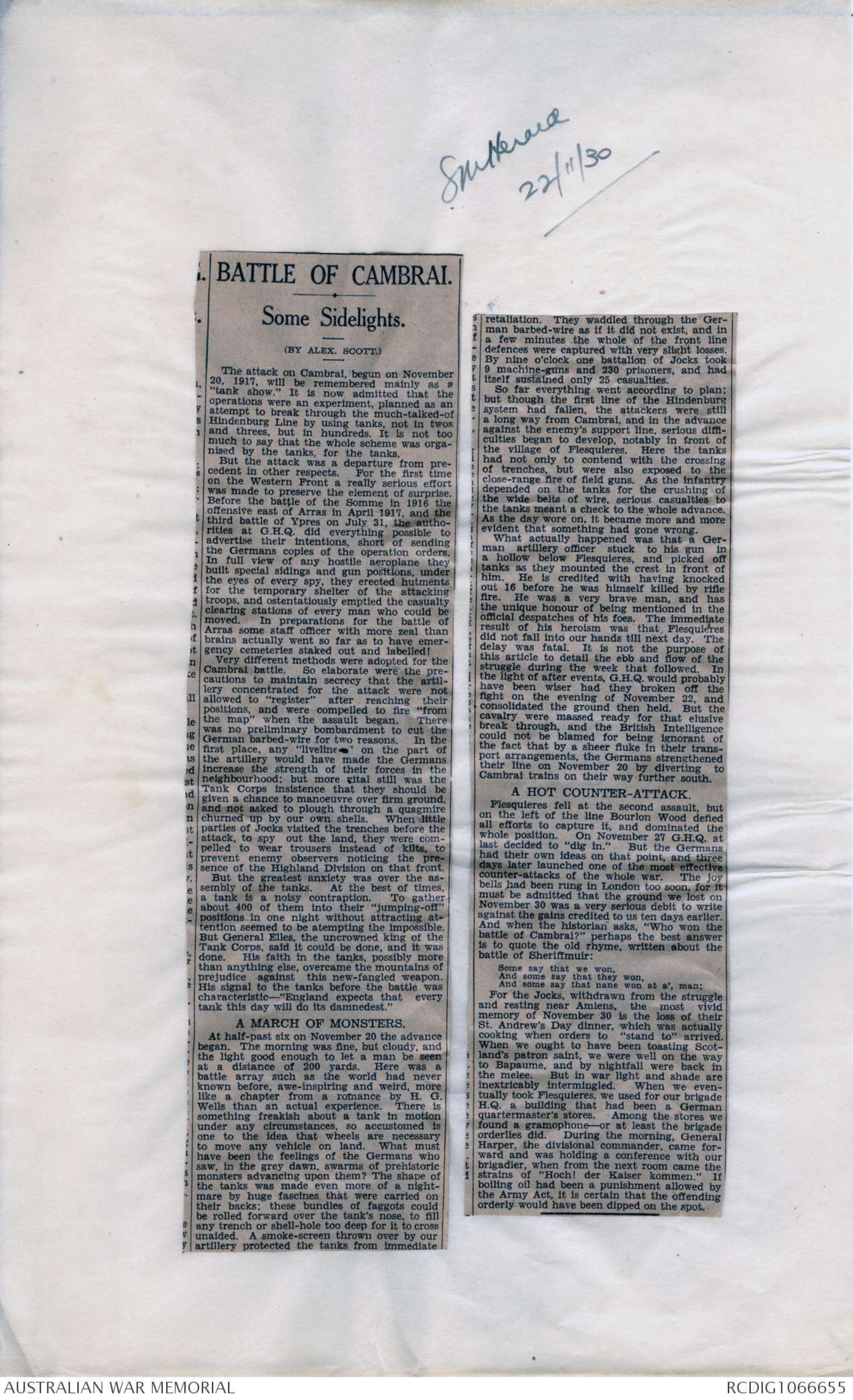
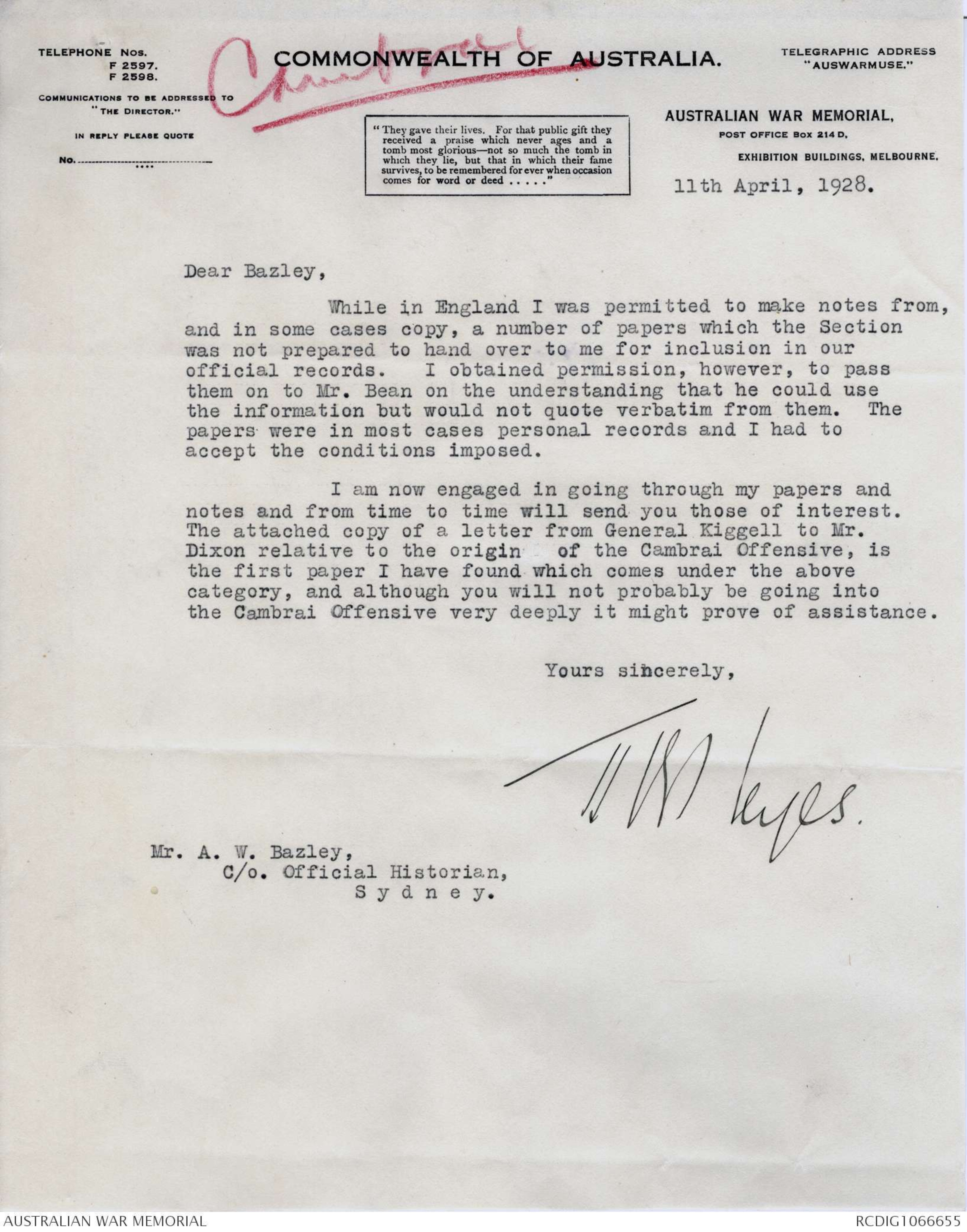
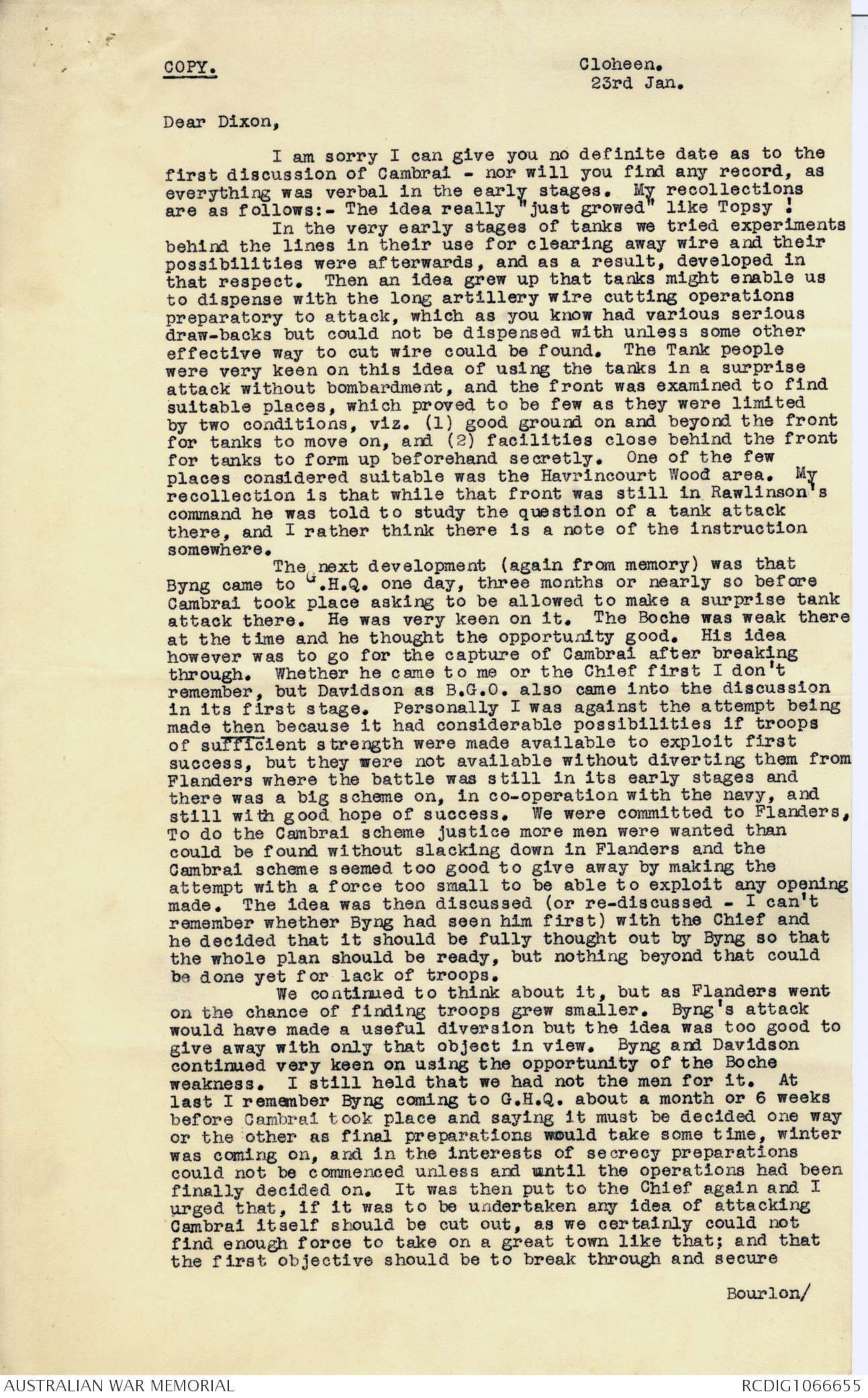
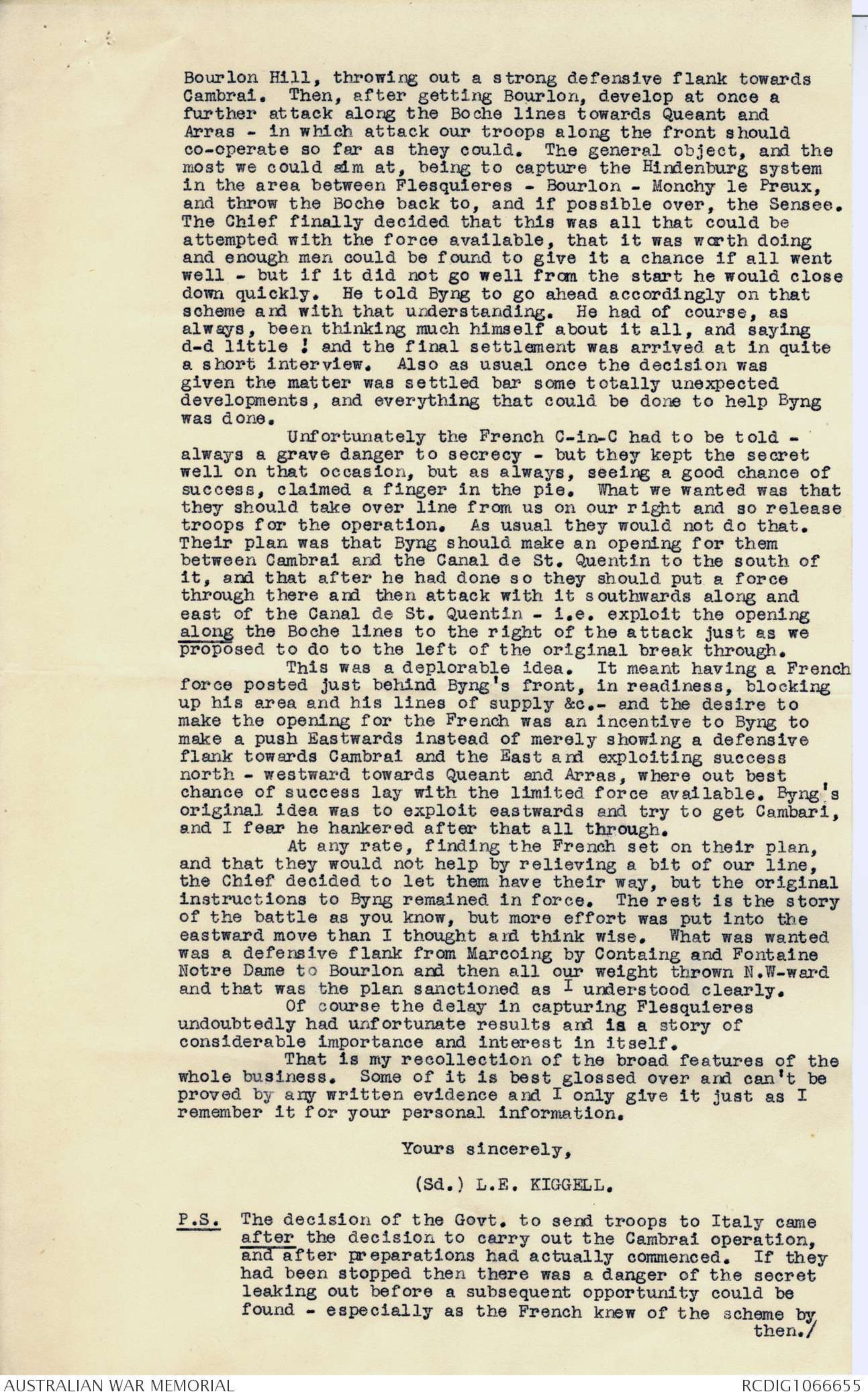
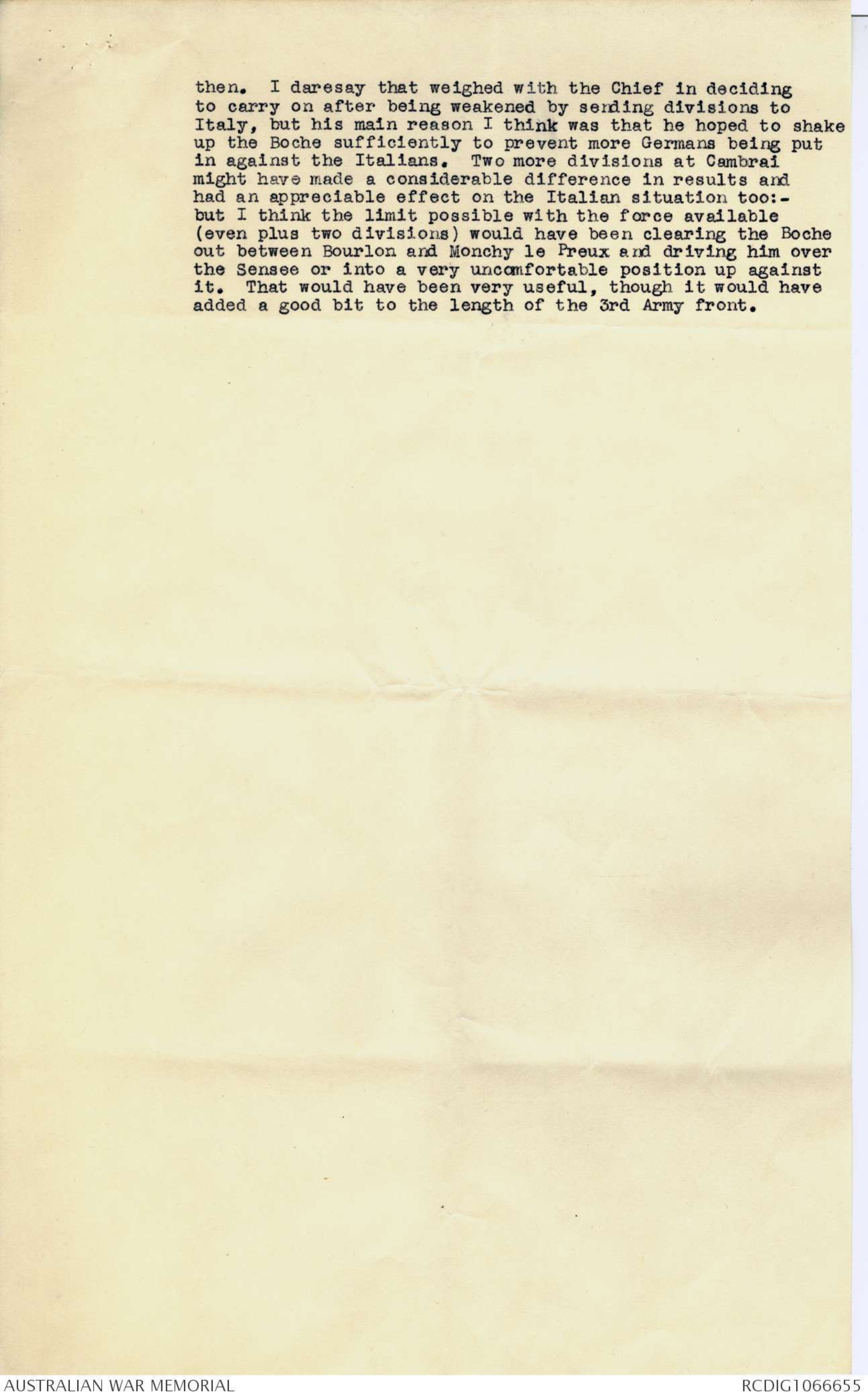
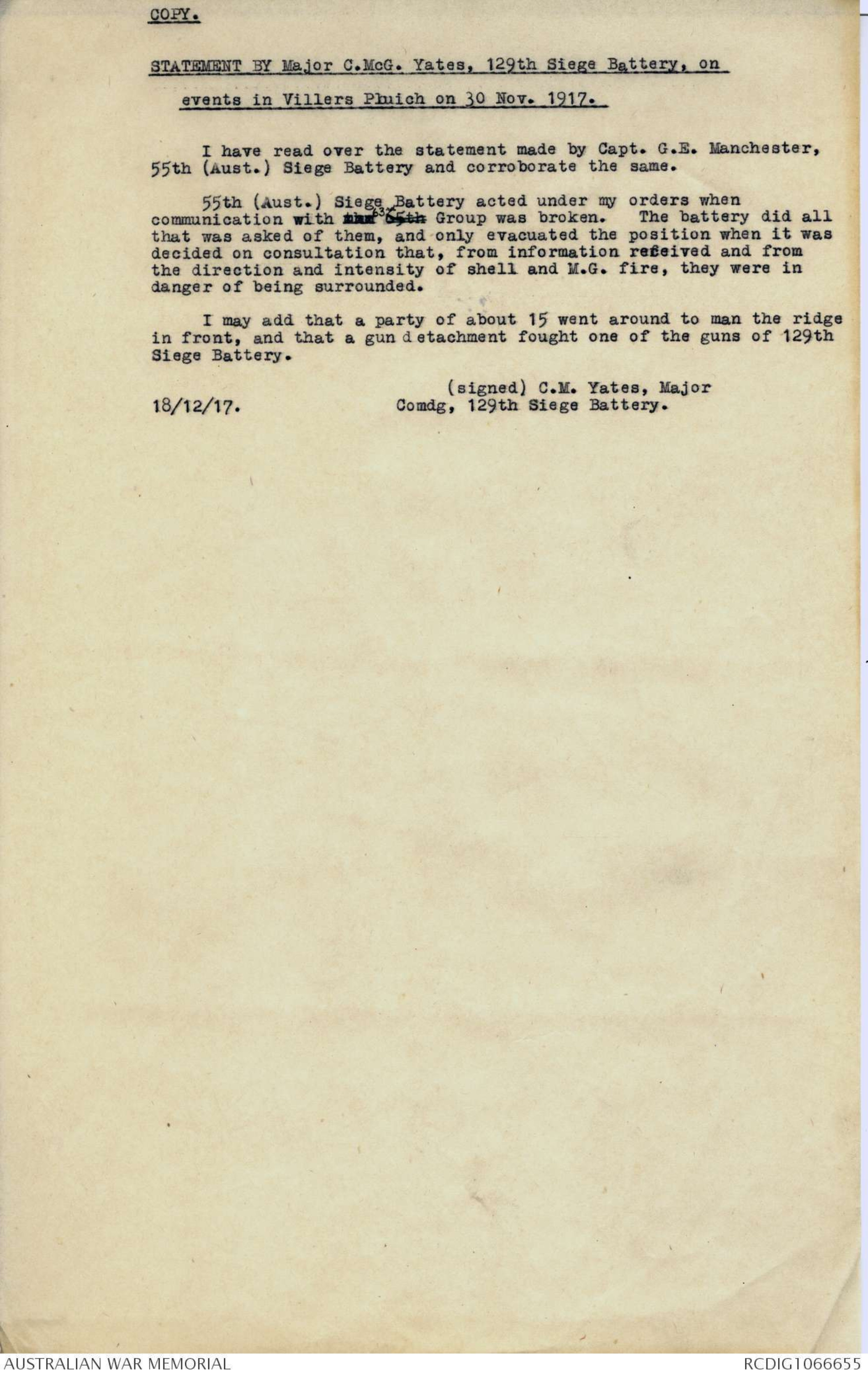
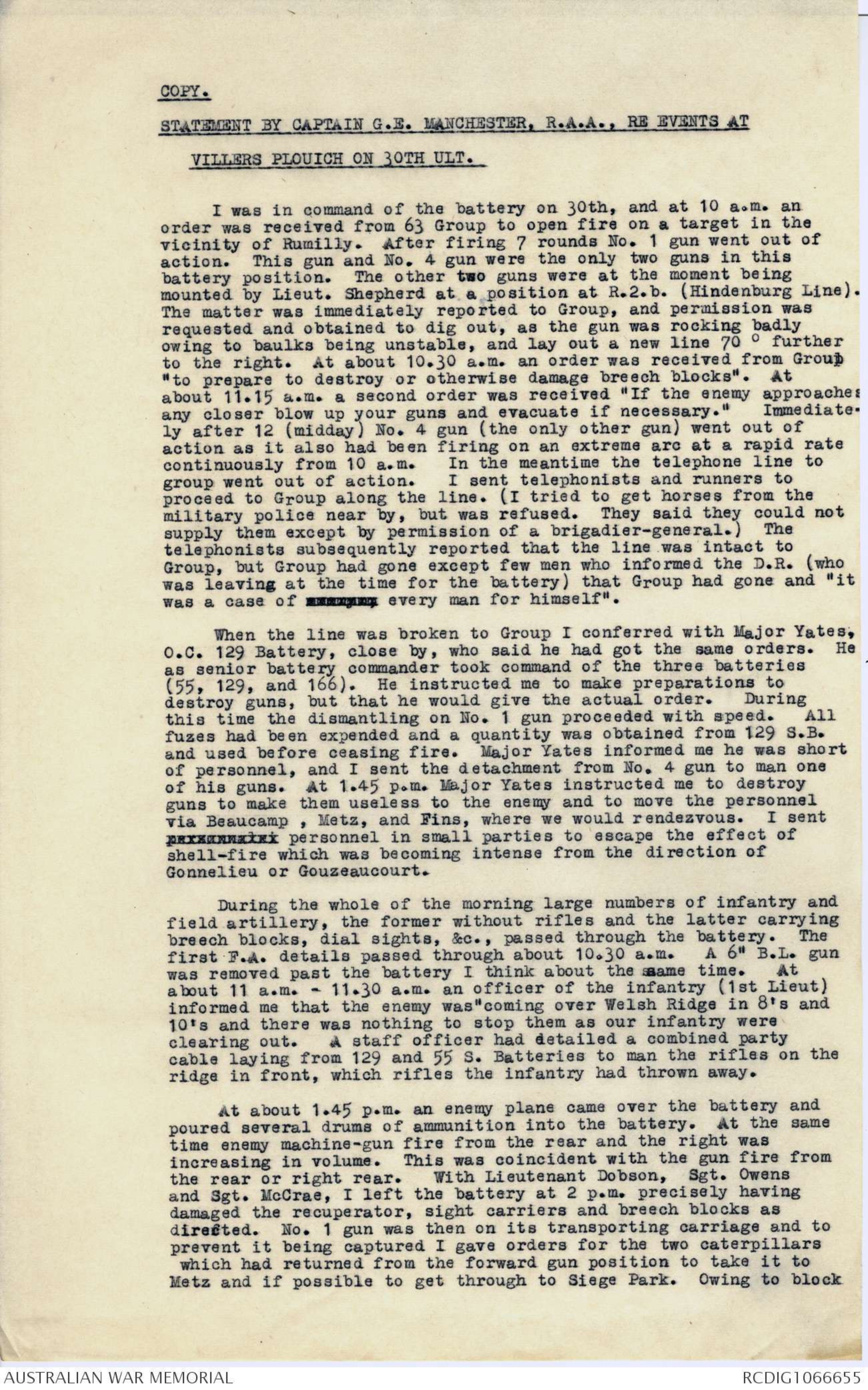
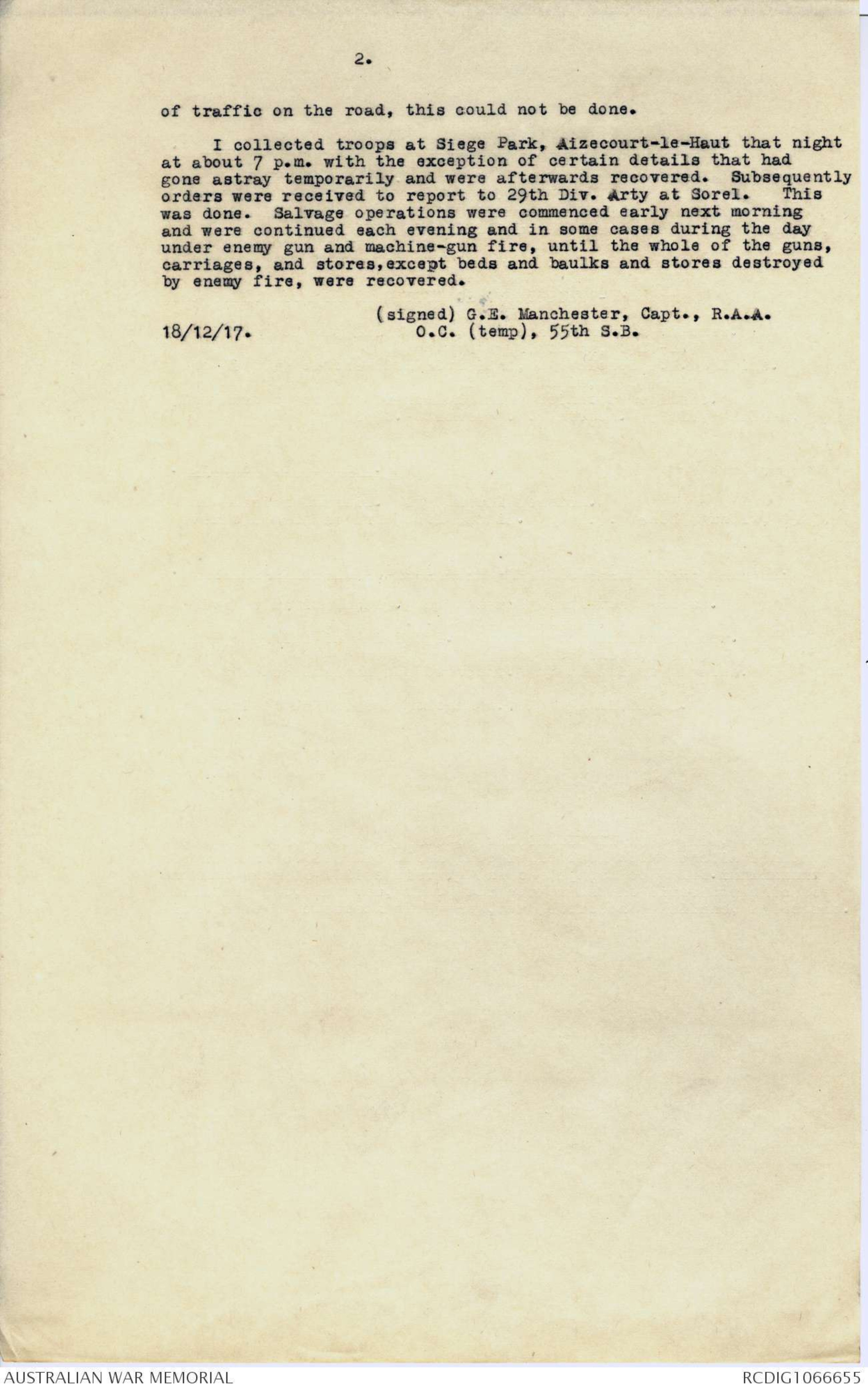
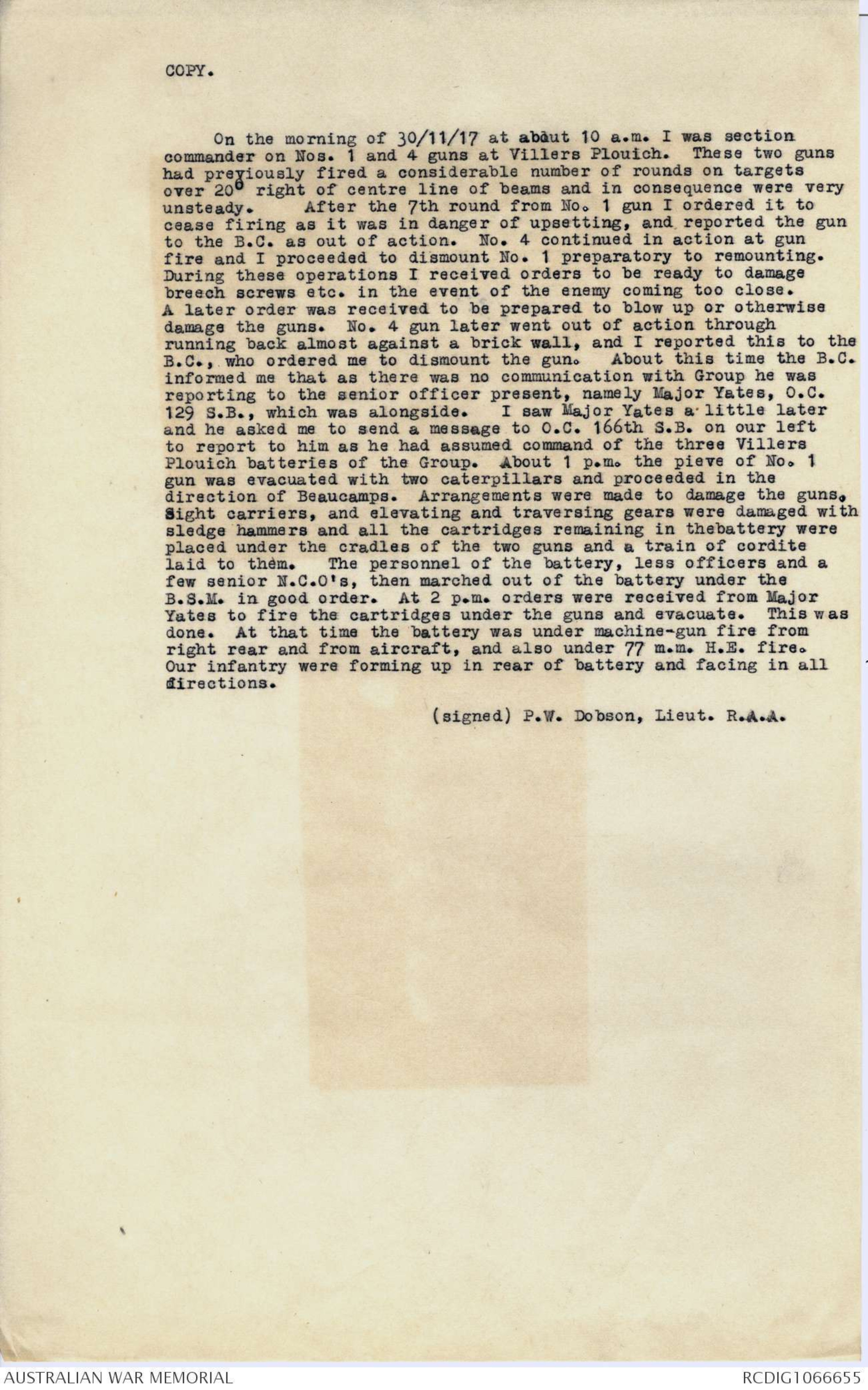

SMHerald
22/11/30
BATTLE OF CAMBRAI.
Some Sidelights.
(BY ALEX. SCOTT.)
The attack on Cambrai, begun on November
20, 1917, will be remembered mainly as a
"tank show." It is now admitted that the
operations were an experiment, planned as an
attempt to break through the much-talked-of
Hindenburg Line by using tanks, not in twos
and threes, but in hundreds. It is not too
much to say that the whole scheme was organised
by the tanks, for the tanks.
But in attack was a departure from precedent
in other respects. For the first time
on the Western Front a really serious effort
was made to preserve the element of surprise.
Before the battle of the Somme in 1916 the
offensive east of Arras in April 1917, and the
third battle Ypres on July 31, the authorities
at G.H.Q. did everything possible to
advertise their intentions, short of sending
the Germans copies of the operation orders.
In full view of any hostile aeroplane they
built special sidings and gun positions, under
the eyes of every spy, they erected hutments
for the temporary shelter of the attacking
troops, and ostentatiously emptied the casualty
clearing stations of every man who could be
moved. In preparations for the battle of
Arras some staff officer with more zeal than
brains actually went so far as to have emergency
cemeteries staked out and labelled!
Very different methods were adopted for the
Cambrai battle. So elaborate were the precautions
to maintain secrecy that the artillery
concentrated for the attack were not
allowed to "register" after reaching their
positions, and were compelled to fire "from
the map" when the assault began. There
was no preliminary bombardment to cut the
German barbed-wire for two reasons. In the
first place, any "liveline[?ss?]" on the part of
the artillery would have made the Germans
increase the strength of their forces in the
neighbourhood; but more vital still was the
Tank Corps insistence that that they should be
given a chance to manoeuvre over firm ground,
and not asked to plough through a quagmire
churned up by our own shells. When little
parties of Jocks visited the trenches before the
attack, to spy out the land, they were compelled
to wear trousers instead of kilts, to
prevent enemy observers noticing the presence
of the Highland Division on that front.
But the greatest anxiety was over the assembly
of the tanks. At the best of times,
a tank is a noisy contraption. To gather
about 400 of them into their "jumping-off"
positions in one night without attracting attention
seemed to be atempting the impossible.
But General Elles, the uncrowned king of the
Tank Corps, said it could be done, and it was
done. His faith in the tanks, possibly more
than anything else, overcame the mountains of
prejudice against this new-fangled weapon.
His signal to the tanks before the battle was
characteristic—"England expects that every
tank this day will do its damnedest."
A MARCH OF MONSTERS.
At half-past six on November 20 the advance
began. The morning was fine, but cloudy, and
the light good enough to let a man be seen
at a distance of 200 yards. Here was a
battle array such as the world had never
known before, awe-inspiring and weird, more
like a chapter from a romance by H. G.
Wells than an actual experience. There is
something freakish about a tank in motion
under any circumstances, so accustomed is
one to the idea that wheels are necessary
to move any vehicle on land. What must
have been the feelings of the Germans who
saw, in the grey dawn, swarms of prehistoric
monsters advancing upon them? The shape of
the tanks was made even more of a nightmare
by huge fascines that were carried on
their backs: these bundles of faggots could
be rolled forward over the tank's nose, to fill
any trench or shell-hole too deep for it to cross
unaided. A smoke-screen thrown over by our
artillery protected the tanks from immediate
retaliation. They waddled through the German
barbed-wire as if it did not exist, and in
a few minutes the whole of the front line
defences were captured with very slight losses.
By nine o'clock one battalion of Jocks took
9 machine-guns and 230 prisoners, and had
itself sustained only 25 casualties.
So far everything went according to plan;
but though the first line of the Hindenburg
system had fallen, the attackers were still
a long way from Cambrai, and in the advance
against the enemy's support line, serious difficulties
began to develop, notably in front of
the village of Flesquieres. Here the tanks
had not only to contend with the crossing
of trenches, but were also exposed to the
close-range fire of field guns. As the infantry
depended on the tanks for the crushing of
the wide belts of wire, serious casualties to
the tanks meant a check to the whole advance.
As the day wore on, it became more and more
evident that something had gone wrong.
What actually happened was that a German
artillery officer stuck to his gun in
a hollow below Flesquieres, and picked off
tanks as they mounted the crest in front of
him. He is credited with having knocked
out 16 before he was himself killed by rifle
fire. He was a very brave man, and has
the unique honour of being mentioned in the
official despatches of his foes. The immediate
result of his heroism was that Flesquieres
did not fall into our hands till next day. The
delay was fatal. It is not the purpose of
this article to detail the ebb and flow of the
struggle during the week that followed. In
the light of after events, G.H.Q. would probably
have been wiser had they broken off the
fight on the evening of November 22, and
consolidated the ground then held. But the
cavalry were massed ready for that elusive
break through, and the British Intelligence
could not be blamed for being ignorant of
the fact that by a sheer fluke in their transport
arrangements, the Germans strengthened
their line on November 20 by diverting to
Cambrai trains on their way further south.
A HOT COUNTER-ATTACK.
Flesquieres fell at the second assault, but
on the left of the line Bourlon Wood defied
all efforts to capture it, and dominated the
whole position. On November 27 G.H.Q. at
last decided to "dig in." But the Germans
had their own ideas on that point, and three
days later launched one of the most effective
counter-attacks of the whole war. The joy
bells had been rung in London too soon, for it
must be admitted that the ground we lost on
November 30 was a very serious debit to write
against the gains credited to us ten days earlier.
And when the historian asks, "Who won the
battle of Cambrai?" perhaps the best answer
is to quote the old rhyme, written about the
battle of Sheriffmuir:
Some say that we won,
And some say that they won,
And some say that nane won at a', man;
For the Jocks, withdrawn from the struggle
and resting near Amiens, the most vivid
memory of November 30 is the loss of their
St. Andrew's Day dinner, which was actually
cooking when orders to "stand to" arrived.
When we ought to have been toasting Scotland's
patron saint, we were well on the way
to Bapaume, and by nightfall were back in
the melee. But in war light and shade are
inextricably intermingled. When we eventually
took Flesquieres, we used for our brigade
H.Q. a building that had been a German
quartermaster's stores. Among the stores we
found a gramophone—or at least the brigade
orderlies did. During the morning, General
Harper, the divisional commander, came forward
and was holding a conference with our
brigadier, when from the next room came the
strains of "Hoch! der Kaiser kommen." If
boiling oil had been a punishment allowed by
the Army Act, it is certain that the offending
orderly would have been dipped on the spot.
COMMONWEALTH OF AUSTRALIA.
Classified
TELEPHONE Nos.
F 2597.
F 2598.
COMMUNICATIONS TO BE ADDRESSED TO
"THE DIRECTOR."
IN REPLY PLEASE QUOTE
No.
TELEGRAPHIC ADDRESS
"AUSWARMUSE."
AUSTRALIAN WAR MEMORIAL,
POST OFFICE Box 214 D,
EXHIBITIONS BUILDINGS, MELBOURNE.
11th April, 1928.
"They gave their lives. For that public gift they
received a praise which never ages and a
tomb most glorious—not so much the tomb in
which they lie, but that in which their fame
survives, to be remembered for ever when occasion
comes for word or deed . . . . ."
Dear Bazley,
While in England I was permitted to make notes from,
and in some cases copy, a number of papers which the Section
was not prepared to hand over to me for inclusion in our
official records. I obtained permission, however, to pass
them on to Mr. Bean on the understanding that he could use
the information but would not quote verbatim from them. The
papers were in most cases personal records and I had to
accept the conditions imposed.
I am now engaged in going through my papers and
notes and from time to time will send you those of interest.
The attached copy of a letter from General Kiggell to Mr.
Dixon relative to the origin of the Cambrai Offensive, is
the first paper I have found which comes under the above
category, and although you will not probably be going into
the Cambrai Offensive very deeply it might prove of assistance.
Yours sincerely,
T H Heyes.
Mr. A. W. Bazley,
C/o. Official Historian,
Sydney.
COPY. Cloheen
23rd Jan.
Dear Dixon,
I am sorry I can give you no definite date as to the
first discussion of Cambrai - nor will you find any record, as
everything was verbal in the early stages. My recollections
are as follows:- The idea really "just growed" like Topsy !
In the very early stages of tanks we tried experiments
behind the lines in their use for clearing away wire and their
possibilities were afterwards, and as a result, developed in
that respect. Then an idea grew up that tanks might enable us
to dispense with the long artillery wire cutting operations
preparatory to attack, which as you know had various serious
draw-backs but could not be dispensed with unless some other
effective way to cut wire could be found. The Tank people
were very keen on this idea of using the tanks in a surprise
attack without bombardment, and the front was examined to find
suitable places, which proved to be few as they were limited
by two conditions, viz. (1) good ground on and beyond the front
for tanks to move on, and (2) facilities close behind the front
for tanks to form up beforehand secretly. One of the few
places considered suitable was the Havrincourt Wood area. My
recollection is that while that front was still in Rawlinson's
command he was told to study the question of a tank attack
there, and I rather think there is a note of the instruction
somewhere.
The next development (again from memory) was that
Byng came to G.H.Q. one day, three months or nearly so before
Cambrai took place asking to be allowed to make a surprise tank
attack there. He was very keen on it. The Boche was weak there
at the time and he thought the opportunity good. His idea
however was to go for the capture of Cambrai after breaking
through. Whether he came to me or the Chief first I don't
remember, but Davidson as B.G.O. also came into the discussion
in its first stage. Personally I was against the attempt being
made then because it had considerable possibilities if troops
of sufficient strength were made available to exploit first
success, but they were not available without diverting them from
Flanders where the battle was still in its early stages and
there was a big scheme on, in co-operation with the navy, and
still with good hope of success. We were committed to Flanders,
To do the Cambrai scheme justice more men were wanted than
could be found without slacking down in Flanders and the
Cambrai scheme seemed to good to give away by making the
attempt with a force to small to be able to exploit any opening
made. The idea was then discussed (or re-discussed - I can't
remember whether Byng had seen him first) with the Chief and
he decided that it should be fully thought out by Byng so that
the whole plan should be ready, but nothing beyond that could
be done yet for lack of troops.
We continued to think about it, but as Flanders went
on the chance of finding troops grew smaller. Byng's attack
would have made a useful diversion but the idea was too good to
give away with only that object in view. Byng and Davidson
continued very keen the opportunity of the Boche
weakness. I still held that we had not the men for it. At
last I remember Byng coming to G.H.Q. about a month or 6 weeks
before Cambrai took place and saying it must be decided one way
or the other as final preparations would take some time, winter
was coming on, and in the interests of secrecy preparations
could not be commenced unless and until the operations had been
finally decided on. It was then put to the Chief again and I
urged that, if it was to be undertaken any idea of attacking
Cambrai itself should be cut out, as we certainly could not
find enough force to take on a great town like that; and that
the first objective should be to break through and secure
Bourlon/
Bourlon Hill, throwing out a strong defensive flank towards
Cambrai. Then, after getting Bourlon, develop at once a
further attack along the Boche lines towards Queant and
Arras - in which attack our troops along the front should
co-operate so far as they could. The general object, and the
most we could aim at, being to capture the Hindenburg system
in the area between Flesquieres - Bourlon - Monchy le Preux,
and throw the Boche back to, and if possible over, the Sensee.
The Chief finally decided that this was all that could be
attempted with the force available, that it was worth doing
and enough men could be found to give it a chance if all went
well - but if it did not go well from the start he would close
down quickly. He told Byng to go ahead accordingly on that
scheme and with that understanding. He had of course, as
always, been thinking much himself about it all, and saying
d-d little ! and the final settlement was arrived at in quite
a short interview. Also as usual once the decision was
given the matter was settled bar some totally unexpected
developments, and everything that could be done to help Byng
was done.
Unfortunately the French C-in-C had to be told -
always a grave danger to secrecy - but they kept the secret
well on that occasion, but as always, seeing a good chance of
success, claimed a finger in the pie. What we wanted was that
they should take over line from us on our right and so release
troops for the operation. As usual they would not do that.
Their plan was that Byng should make an opening for them
between Cambrai and the Canal de St. Quentin to the south of
it, and that after he had done so they should put a force
through there and then attack with it southwards along and
east of the Canal de St. Quentin - i.e. exploit the opening
along the Boche lines to the right of the attack just as we
proposed to do to the left of the original break through.
This was a deplorable idea. It meant having a French
force posted just behind Byng's front, in readiness, blocking
up his area and his lines of supply &c.- and the desire to
make the opening for the French was an incentive to Byng to
make a push Eastwards instead of merely showing a defensive
flank towards Cambrai and the East and exploiting success
north - westward towards Queant and Arras, where out best
chance of success lay with the limited force available. Byng's
original idea was to exploit eastwards and try to get Cambari,
and I fear he hankered after that all through.
At any rate, finding the French set on their plan,
and that they would not help by relieving a bit of our line,
the Chief decided to let them have their way, but the original
instructions to Byng remained in force. The rest is the story
of the battle as you know, but more effort was put into the
eastward move than I thought and think wise. What was wanted
was a defensive flank from Marcoing by Containg and Fontaine
Notre Dame to Bourlon and then all our weight thrown N.W-ward
and that was the plan sanctioned as I understood clearly.
Of course the delay in capturing Flesquieres
undoubtedly had unfortunate results and is a story of
considerable importance and interest in itself.
That is my recollection of the broad features of the
whole business. Some of it is best glossed over and can't be
proved by any written evidence and I only give it just as I
remember it for your personal information.
Yours sincerely,
(Sd.) L.E. KIGGELL.
P.S. The decision of the Govt. to send troops to Italy came
after the decision to carry out the Cambrai operation,
and after preparations had actually commenced. If they
had been stopped then there was a danger of the secret
leaking out before a subsequent opportunity could be
found - especially as the French knew of the scheme by
then./
then. I daresay that weighed with the Chief in deciding
to carry on after being weakened by sending divisions to
Italy, but his main reason I think was that he hoped to shake
up the Boche sufficiently to prevent more Germans being put
in against the Italians. Two more divisions at Cambrai
might have made a considerable difference in results and
had an appreciable effect on the Italian situation too:-
but I think the limit possible with force available
(even plus two divisions) would have been clearing the Boche
out between Bourlon and Monchy le Preux and driving him over
the Sensee or into a very uncomfortable position up against
it. That would have been very useful, though it would have
added a good bit to the length of the 3rd Army front.
COPY.
STATEMENT BY Major C.McG. Yates, 129th Siege Battery, on
events in Villers Plouich on 30 Nov. 1917.
I have read over the statement made by Capt. G.E. Manchester,
55th (Aust.) Siege Battery and corroborate the same.
55th (Aust.) Siege Battery acted under my orders when
communication with the 65th 63rd Group was broken. The battery did all
that was asked of them, and only evacuated the position when it was
decided on consultation that, from information received and from
the direction and intensity of shell and M.G. fire, they were in
danger of being surrounded.
I may add that a party of about 15 went around to man the ridge
in front, and that a gun detachment fought one of the guns of 129th
Siege Battery.
(signed) C.M. Yates, Major
Comdg, 129th Siege Battery.
18/12/17
COPY.
STATEMENT BY CAPTAIN G.E. MANCHESTER, R.A.A., RE EVENTS AT
VILLERS PLOUICH ON 30TH ULT.
I was in command of the battery on 30th, and at 10 a.m. an
order was received from 63 Group to open fire on a target in the
vicinity of Rumilly. After firing 7 rounds No. 1 gun went out of
action. This gun and No. 4 gun were the only two guns in this
battery position. The other two guns were at the moment being
mounted by Lieut. Shepherd at a position at R.2.b. (Hindenburg Line).
The matter immediately reported to Group, and permission was
requested and obtained to dig out, as the gun was rocking badly
owing to baulks being unstable, and lay out a new line 70 ° further
to the right. At about 10.30 a.m. an order was received from Group
"to prepare to destroy or otherwise damage breech blocks". At
about 11.15 a.m. a second order was received "if the enemy approaches
any closer blow up your guns and evacuate if necessary." Immediately
after 12 (midday) No. 4 gun (the only other gun) went out of
action as it also had been firing on an extreme arc at a rapid rate
continuously from 10 a.m. In the meantime the telephone line to
group went out of action. I sent telephonists and runners to
proceed to Group along the line. (I tried to get horses from the
military police near by, but was refused. They said they could not
supply them except by permission of a brigadier-general.) The
telephonists subsequently reported that the line was intact to
Group, but Group had gone except few men who informed the D.R. (who
was leaving at the time for the battery) that Group had gone and "it
was a case everyxxx every man for himself".
When the line was broken to Group I conferred with Major Yates,
O.C. 129 Battery, close by, who said he had got the same orders. He
as senior battery commander took command of the three batteries
(55, 129, and 166). He instructed me to make preparations to
destroy guns, but that he would give the actual order. During
this time the dismantling on No. 1 gun proceeded with speed. All
fuses had been expended and a quantity was obtained from 129 S.B.
and used before ceasing fire. Major Yates instructed me he was short
of personnel, and I sent the detachment from No. 4 gun to man one
of his guns. At 1.45 p.m. Major Yates instructed me to destroy
guns to make them useless to the enemy and to move the personnel
via Beaucamp, Metz, and Fins, where we could rendezvous. I sentpersonelxi personnel in small parties to escape the effect of
shell-fire which was becoming intense from the direction of
Gonnelieu or Gouzeaucourt.
During the whole of the morning large numbers of infantry and
field artillery, the former without rifles and the latter carrying
breech blocks, dial sights, &c., passed through the battery. The
first F.A. details passed through about 10.30 a.m. A 6" B.L. gun
was removed past the battery I think about the same time. At
about 11 a.m. - 11.30 a.m. an officer of the infantry (1st Lieut)
informed me that the enemy "was coming over Welsh Ridge in 8's and
10's and there was nothing to stop them as our infantry were
clearing out. A staff officer had detailed a combined party
cable laying from 129 and 55 S. Batteries to man the rifles on the
ridge in front, which rifles the infantry had thrown away.
At about 1.45 p.m. an enemy plane came over the battery and
poured several drums of ammunition into the battery. At the same
time enemy machine-gun fire from the rear and the right was
increasing in volume. This was coincident with the gun fire from
the rear or right rear. With Lieutenant Dobson, Sgt. Owens
and Sgt. McCrae, I left the battery at 2 p.m. precisely having
damaged the recuperator, sight carriers and breech blocks as
directed. No. 1 gun was then on its transporting carriage and to
prevent it being captured I gave orders for the two caterpillars
which had returned from the forward gun position to take it to
Metz and if possible to get through to Siege Park. Owing to block
2.
of traffic on the road, this could not be done.
I collected troops at Siege Park, Aizecourt-le-Haut that night
at about 7 p.m. with the exception of certain details that had
gone astray temporarily and were afterwards recovered. Subsequently
orders were received to report to 29th Div. Arty at Sorel. This
was done. Salvage operations were commenced early next morning
and were continued each evening and in some cases during the day
under enemy gun and machine-gun fire, until the whole of the guns,
carriages, and stores, except beds and baulks and stores destroyed
by enemy fire, were recovered.
(signed) G.E. Manchester, Capt., R.A.A.
O.C. (temp), 55th S.B.
18/12/17.
COPY.
On the morning of 30/11/17 at about 10 a.m. I was section
commander on Nos. 1 and 4 guns at Villers Plouich. These two guns
had previously fired a considerable number of rounds on targets
over 20° right of centre line of beams and in consequence were very
unsteady. After the 7th round from No. 1 gun I ordered it to
cease firing as it was in danger of upsetting, and reported the gun
to the B.C. as out of action. No. 4 continued in action at gun
fire and I proceeded to dismount No. 1 preparatory to remounting.
During these operations I received orders to be ready to damage
breech screws etc. in the event of the enemy coming too close.
A later order was received to be prepared to blow up or otherwise
damage the guns. No. 4 gun later went out of action through
running back almost against a brick wall, and I reported this to the
B.C., who ordered me to dismount the gun. About this time the B.C.
informed me that as there was no communication with Group he was
reporting to the senior officer present, namely Major Yates, O.C.
129 S.B., which was alongside. I saw Major Yates a little later
and he asked me to send a message to O.C. 166th S.B. on our left
to report to him as he had assumed command of the three Villers
Plouich batteries of the Group. About 1 p.m. the pieve of No. 1
gun was evacuated with two caterpillars and proceeded in the
direction of Beaucamps. Arrangements were made to damage the guns,
sight carriers, and elevating and traversing gears were damaged with
sledge hammers and all the cartridges remaining in thebattery were
placed under the cradles of the two guns and a train of cordite
laid to them. The personnel of the battery, less officers and a
few senior N.C.O's, then marched out of the battery under the
B.S.M. in good order. At 2 p.m. orders were received from Major
Yates to fire the cartridges under the guns and evacuate. This was
done. At that time the battery was under machine-gun fire from
right rear and from aircraft, and also under 77 m.m. H.E. fire.
Our infantry were forming up in rear of battery and facing in all
directions.
(signed) P.W. Dobson, Lieut. R.A.A.
Mutiny at the Base : An Eye-Witness's
Story
To the Editor of the "Evening Standard."
Sir,- As an eye-witness of the Mutiny at the
Base in 1917, described in "The Patriot's Progress,"
I submit that the cause was not that
"the boys were fed up with the slaughter going
on up in the Salient, but these facts:
On the night in question an "Aussie" had
been arrested by the "Red Caps" and held in
detention in their hut just opposite the hall
used as a military cinema. The friends of this
"Aussie" rushed up to their I.B.D. (Infantry
Base Depot) and turned out all available
"Aussies." They reached the police hut and
demonstrated just as the cinema was turning
out.
The Military Police "got the wind up" at
the huge crowd in front of their hut (mostly
innocent Highland Division cinema goers), and
one fired his revolver over the heads of the
immediate "Aussies" in front of him and hit
and killed an innocent corporal of the Gordons
just leaving the cinema.
After that the crowd (chiefly Aussies) rushed
the police hut, and the Red Caps fled for their
lives, some into Etaples and rest into the
R.T.O.'s office down in the cutting.
As sergeant in charge of the orderly room
of 18th I.B.D. on that night I was 'phoned by
"Reinforcements" to have a guard turned out
to surround the R.T.O.'s office and to clear the
main line (Boulogne, Amiens, Paris) then
covered by mutinous troops stoning the
R.T.O.'s office.
A guard of "Jocks" (the only troops the
"Aussies" would respect) was turned out, the
Red Caps rescued and the line cleared.
The A.P.M. was not rolled in the road,
although he certainly had his "red hat" taken.
There was insubordination for a day or so as
regards "Bull Ring" parades, but on a certain
"Bull Ring" colonel being removed things
became normal.
SERGEANT,
1/6th Seaforth Highlanders, 51st Highland
Division, 18th I.B.D., Etaples.
North Harrow.
MUTINY AT THE BASE.
[*HN*]
MORE EX-SOLDIERS' VIEWS
ON ETAPLES OUTBREAK.
The conflict of testimony as to what actually
caused the outbreak of mutiny at Etaples
(referred to in "The Patriot's Progress," Mr.
Henry Williamson's war serial in the "Evening
Standard") in 1917 continues.
[*We have the
book here
AWB*]
An ex-officer of the Royal Artillery writes:
As one actively concerned in the transfer of
the Australian Base Depots to Havre in 1917,
I can assure ex-Sergeant, 51st Highland Division,
that there was no Australian Base Depot in
Etaples at the time of the riot. Their depots had
been taken over by the Canadian Corps, with
whom we had effected an exchange in order to
facilitate the transfer of troops from our respective
depots in the United Kingdom.
Ex-Corporal, 8th Middlesex Regiment, writes:
I was an eye-witness of the mutiny at Etaples.
Two New Zealanders were talking to some
members of the W.A.A.C. outside the guardroom
by the railway bridge. "Red-caps" told
them to move away. A fight took place and a
crowd gathered. A "Red-cap" fired and fatally
wounded a "Jock" and also wounded a French
woman. He took refuge in the officers' baggage
hut on the railway siding, and two or three
hundred armed "Jocks" were called out to
protect him.
The guardroom windows were smashed, and
an attempt was made to set it on fire. I think
the number of "Red-caps" killed in this mutiny
was six or eight. The troops were afterwards
barred from the town for a week after a certain
brigadier-general had severely reprimanded the
crowd.
 Sam scott
Sam scottThis transcription item is now locked to you for editing. To release the lock either Save your changes or Cancel.
This lock will be automatically released after 60 minutes of inactivity.